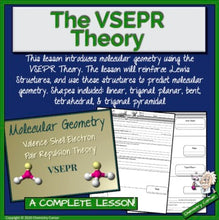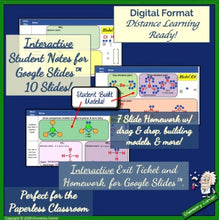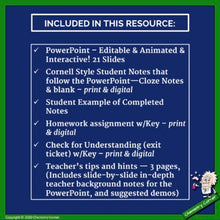Updated: Now includes editable, print, & digital options for the lesson. Perfect for distance learning or the paperless classroom. Interactive student notes, exit ticket, and homework for Google Slides™, for use with Google Apps™. Also updated with editable student notes, homework, & exit ticket.
At this point, students should be able to draw Lewis structures and have an understanding of covalent bonding. In this lesson, students will be introduced to molecular geometry. The lesson will reinforce drawing Lewis Structures, and then using their drawings, students will predict the molecular geometry of molecules. Six main molecular shapes are included: linear, trigonal planar, tetrahedral, trigonal pyramidal, and two forms of the bent molecule. I have my students learn these six. If you want to include other molecular shapes, you can use the editable PowerPoint to add slides of your own.
Depending on your level of students and your standards, this may be considered an honors level lesson.
Lesson Objectives:
* Explain the VSEPR Theory including its basis and assumption
* Predict the molecular shape of molecules based on the Lewis Structure
* Predict the shapes of polyatomic ions based on the Lewis Structure
* Explain the effect of lone pairs of electrons on the molecular geometry of the molecule
* Determine molecular geometry according to the VSEPR Theory for linear, trigonal planar, tetrahedral, trigonal pyramidal, and bent shapes (2)
Prior Knowledge:
An understanding of covalent bonding and Lewis Structures
Lesson Duration: 1 class period
Included in This Resource:
* PowerPoint Presentation – Editable & Animated
* Student Notes – Cloze Notes, editable, print & digital
* Student Notes – Blank
* Student Notes Suggested KEY
* Exit Ticket – Check for Understanding w/ KEY, editable, print & digital
* Homework/Practice w/ KEY, editable, print & digital
* Teacher Notes (4 pages full of some great background info)
Teacher Prep Time: just print and go!
Note on the PowerPoints: The PowerPoints included in this product are editable. They are also animated, which means that they may appear busy or overlapping in the slide edit mode, but will be awesome in the slide show mode! Please don’t edit the PowerPoints until you have seen them in the slide show mode!
This lesson is appropriate for grades 9-12 chemistry
This will be a lesson you will want to use year after year!
Chemistry Corner
*************************************************************************************
Check out these other products that you may be interested in:
Chemical Bonding: An Introductory Lesson on Types of Chemical Bonds
Chemical Bonding: Ionic Bonds & Ionic Compounds
Chemical Bonding: Covalent Bonds & Lewis Structures
Chemical Bonding: Metallic Bonds & Alloys
Chemistry Doodle Notes for the Year – A Growing Bundle
High School Chemistry Year Curriculum: A Growing Bundle
*************************************************************************************
Chemistry Corner’s PowerPoints are perfect for the flipped classroom. However, please read the Copyright Terms below before using them as such. Thanks!
LICENSING TERMS: By downloading this product, you own a license for one teacher only for personal use in your classroom. Licenses are non-transferable, meaning they cannot be passed from one teacher to another. No part of this resource is to be shared with colleagues or used by an entire grade level, school, or district without purchasing the proper number of licenses. I you are a coach, principal or district interested in transferable licenses to accommodate yearly staff changes, please contact Chemistry Corner.
COPYRIGHT TERMS: ©Chemistry Corner. Please note – all material included in this resource belongs to Chemistry Corner. By downloading, you have a license to use the material, but you do not own the material. This resource, or any portion of this resource, may not be uploaded to the internet in any form, including classroom/personal websites or network drives, unless the site is password protected and can only be accessed by students—no other teachers or anyone else on the internet.








